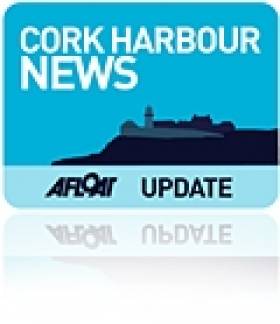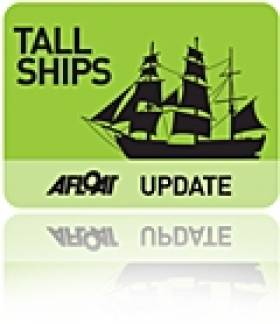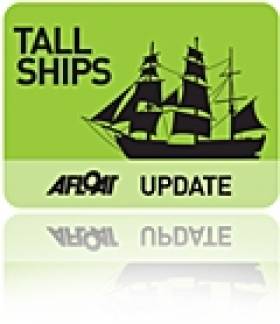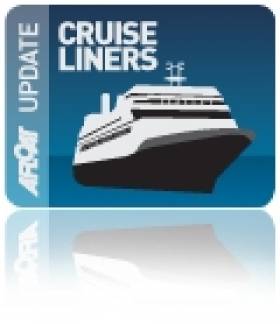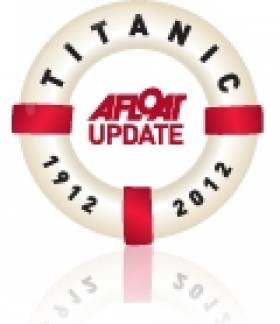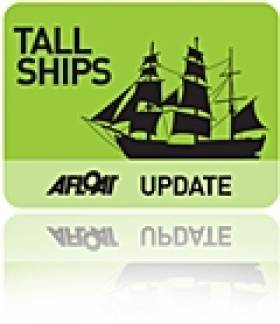Displaying items by tag: TallShips
Norwegian Tallship to Remain On Cork Visit As Trainees Study In Port
#Tallships - The Norwegian tallship, Christian Radich, one year short of its 80th anniversary sailed upriver from a Cork Harbour anchorage to berth in the city this morning, writes Jehan Ashmore.
The fully-rigged ship it transpires did not depart into the open seas today as previously reported. Instead the 1937 built ship berthed at the North Custom House Quay.
The visit to the city-centre is private and will run beyond the weekend to at least mid-week. This it to facilitate trainees who are to attend a maritime course.
Christian Radich is one of two of Norway’s most famous large tallships, the other ship been Statsraad Lehmkuhl dating to 1914.
The square-rigger in August made a visit to Dublin as part of National Heritage Week.
US Training Ships Mark New and Old Ties with Cork Harbour
#UStrainingShips - A pair of US training vessels, one under sail the other motor-propelled have made new and continued old ties with Cork Harbour, writes Jehan Ashmore.
Following a transatlantic sail from the US East coast, the SSV Corwith Cramer which as previously reported made her first visit to Cork City is berthed at the marina and was made open to the public yesterday.
The 1988 built sail training vessel belongs to the Sea Education Association (SEA) and the school ship will spend over a week on the river Lee. She is expected to depart next Sunday and continue her first visit to ports on the European mainland.
Meanwhile, the other US vessel reported earlier is the veteran merchant training ship T.S. Empire State (1962/14,557grt) which has been berthed in lower Cork Harbour at Cobh has since departed.
Having said that, the former general-cargoship now a training ship of the Maritime College of the State University College of New York (SUNY) remains currently at anchor off Cork Harbour.
The ship has made Cork her Irish port of call on several occasions in addition to Dublin. Her cadets are preparing to embark on the next leg of her annual Summer Sea Term where the Danish capital of Copenhagen is her next port of call.
#LegenderryTallShips – The Legenderry Maritime Festival held in the north-west city is where Lough Foyle has welcomed the return of the Clipper Round the World Yacht Race 2014 but also some visiting tall-ships which too are open to the public.
So why not come along and board the tallships, Earl of Pembroke and Phoenix which together have appeared in many films and TV drama's and are berthed alongside McFarland Quay. From that quayside you can embark on board these wonderful sailing vessels which are open only today, (Thursday up to 6pm). For more details of festival programme visit here.
Since the festival began on mid-summers day and concludes on Sunday 29 June, the city and along Foyle Quay has been host for the homecoming festival in welcoming the 12 strong fleet of Clipper 70 yachts. Notably as previously reported, the Derry-Londonderry-Doire skippered by the city's hero, Sean McCarter following victory in race 14 from New York to the yacht's homeport as part of the world's longest ocean race.
There will also opportunities to visit these impressive racing boats as according to the festival organiser website click HERE, Clipper Ventures are making available two of the race yachts for tours today between (2-7pm), tomorrow Friday, June 27 (2-7pm) and also on Saturday, June 28 (9am-1pm).
Forming the focalpoint of the festival is at Foyle Quay where the summer promenade, complete with race village, marine marquees, award winning continental markets and a host of sea faring activities on and off shore will be held for all to enjoy.
So to soak up the action be it learning to canoe or sail a dingy or if you're happy to just go with the flow of the festival there's something to suit everyone. Come on, dive in and blow your inhibitions out of the water!
Last but not least will be the festival's farewell send-off in bidding bon voyage to the Clipper yachts as the Parade of Sail departs on Sunday (12 noon) from MacFarland Quay for the race start at Greencastle in Co Donegal.
The Red Arrows will perform their trademark formations with close-passes and dynamic loops and rolls at the mouth of the River Foyle between Greencastle in Co. Donegal and Magilligan/Binevenagh in Co. Derry.
For more information on the full programme of events or details on how to get involved, visit www.legenderrymaritimefestival.com
#DroghedaTallShips- Now that the tallships in Drogheda Port have departed, the memories remain of ketches stretched along quaysides that also date back a century ago and longer, writes Jehan Ashmore
The 1904 built West Country trading ketch, Bessie Ellen, was one of the seven majestic sailing vessels to attend the event officially titled The Irish Maritime Festival. The three-day event follows last year's inaugural festival.
Thousands were drawn down to the quays where the eclectic gathering of vessels had berthed along Merchants and Steam Packet Quays. Both quays conveniently within reach for pedestrians to stroll along from the heart of Drogheda town centre and to where the quays end at the foot of the railway viaduct.
Making an appearance on the Saturday was the Irish-flagged Spirit of Oysterhaven, the 70 ft schooner is Ireland's only 'non-naval' sail training vessel which slipped under the Dublin-Belfast railway line. She berthed close to the 80 year old Soteria with a white hull and red band while alongside her was the all black schooner Vilma.
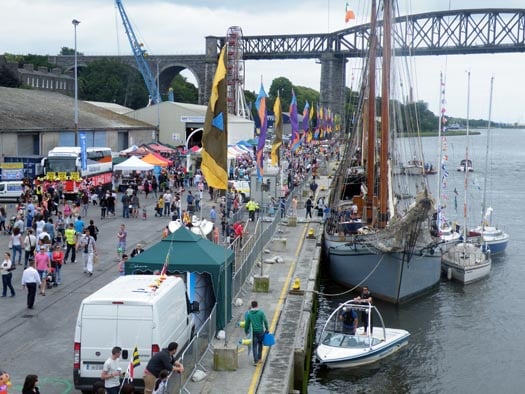
The distinctive light grey hull of ketch Irene, seen moored alongside Drogheda town quays
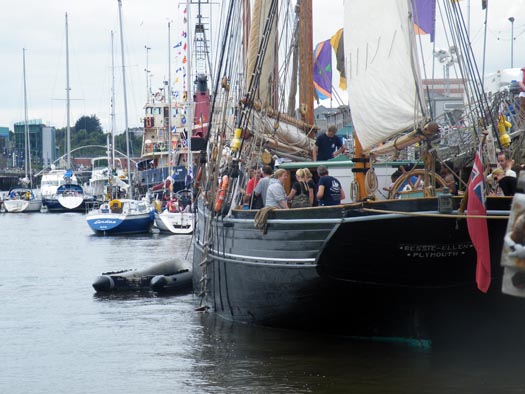
Festival-goers roam the decks of Bessie Ellen and berthed ahead the hopper dredger Hebble Sand
Arguably the most rustic of the flotilla was the gaff-ketch former trawler Keewaydin which this year celebates her 101st year on the water. She had sailed from Dun Laoghaire Harbour having departed from her last UK port in Falmouth. Berthed ahead was the former Baltic trading ketch Ruth which as previously reported anchored off Dalkey in recent weeks.
The third and final ketch caller was the light-grey hulled Irene of 1907, which took part in last year’s 'Sail Home to Your Roots' event as part of the Gathering.
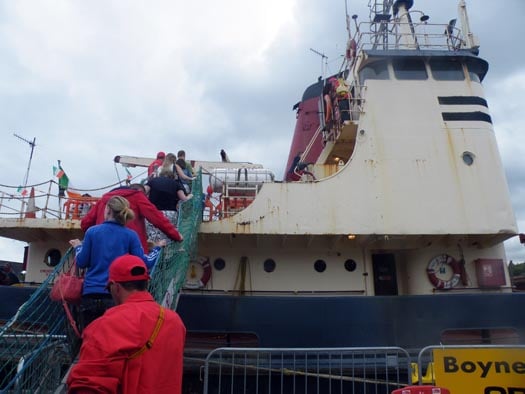
Another classic vessel, albeit without sails, the 'Hebble Sand' (pictured above) is a grab-hopper dredger built in 1963 which was made open to the public. The opportunity gave visitors a greater insight into the working operations of the 757 tonnes vessel which remains employed after more than five decades serving UK and Irish ports.
Her most recent job was carried out at the festival's host port in which Afloat.ie previously reported. The Dundalk-registered vessel is from where for many years she was based in the neighbouring Louth homeport port until sold to current owners Abco Marine.
Stena Set Sails and Passenger Sales
#StenaTALLSHIP – One associates, Stena Line primarily with ferries operating across the Irish Sea, however through a division of the Stena Group, Northern Marine Management are responsible for the UK brig STA Stavros S. Niarchos, writes Jehan Ashmore.
The 59m vessel which berthed in Dublin Port today and is due to depart tomorrow is coincidental in timing as Stena Line's acquisition of Celtic Link Ferries is effective as also of today, with their first sailing tomorrow when the Tall Ships Youth Trust Sail vessel also heads out to sea.
Northern Marine Management also manages a diverse range of merchant shipping in their portfolio of more than 130 vessels including very large crude carriers (VLCC).
The Clydebank based ship, crew, and technical service management company earlier this year formed Northern Marine Ferries, which today added the former Celtic Link ro-pax Celtic Horizon to its book of vessels that they are managing for Stena Line's Irish Sea fleet.
Small Yet Smart Brigantine Sets Sails Across the Irish Sea
#Tallships- The Sea Cadet's training tallship TS Royalist this morning departed Dun Laoghaire Harbour under the command of Skipper Angela Morris, following an overnight visit after setting off from Milford Haven in Pembrokeshire, writes Jehan Ashmore.
Royalist may be small with only 29m in length and on a beam of just over 6m, yet with her smart distinct black and white hull band colours she is easily recognisable wherever she visits ports and harbours throughout the UK.
Her 8-strong crew and 24 sea cadets are on a voyage bound for Oban, Scotland, with an en route call to Belfast so in order to exchange a new cadet crew.
Throughout her career Royalist has visited Irish ports and in recent years she has participated in the Tall Ship Races to include Waterford City in 2011 and also back in 2006 where the Asgard II, also a brigantine and of similar size led to both crews having shared a competitive yet equally friendly relationship.
This was to be Asgard II's final Irish Tall Ships Race before she sank off the Breton coast and in what will be her fifth year since the incident took place in September 2008.
The UK flagged brigantine however dates to decade earlier having been completed in 1971 though at this stage the flagship is nearing the end of her career with the Sea Cadets which has helped countless young people to experience sailing throughout the UK. The origins of the Sea Cadets date to 1856 where young given instructions on a naval theme.
Present-day activities of the Sea Cadets involve 14,000 young people based in 400 units throughout towns, cities and ports in the UK. The cadets are presented challenges while also developing new skills, like sailing, boating and even rock climbing. All this work is provided with the support of 9,000 volunteers.
Sea cadets age between 10-17 years old and they are divided into the following age groups- Junior cadets (10-12), Sea Cadets(12 -17) and the Royal Marines Cadets ranging between 13-17 respectively.
Royalist is nearing the end of her career and funds are required to build a slightly larger replacement with the Sea Cadets launching a new ship appeal campaign, so that future generations can continue the chance to sail at sea until the mid-21st century.
Majestic Tall-Cruise-Ship With White Clouds Too
#TallCruiseShip- One good easily think another tallship visitor has called to Dublin Port, however what makes the majestic 117m Sea Cloud II stand out is not just beauty but that she is a cruiseship and with a mere 64 guests on board the luxury vessel, writes Jehan Ashmore.
The three-masted Sea Cloud II is to remain berthed overnight in the capital tonight, so allowing her guests another day to explore having docked early this morning from Cork Harbour. She is berthed at Sir John Rogersons Quay within the 'Docklands' Quarter of the city.
Despite her appearance, the barque was only built in 2001 and she can set a total sail area of approximately 32,150 sq. feet (3.000 m²), noting to scroll down the page for sail-plan.
Operated by Sea Cloud Cruises the Maltese flagged vessel is berthed between the Samuel Beckett swing-bridge and the East-Link toll-lift bridge. Should you be around including those taking a lunch-break in the neighbouring office- blocks, a closer inspection is worth the stroll along the campshires.
Sea Cloud II is scheduled to depart around teatime tomorrow and she follows exactly a week ago to the departure of the five-masted Club Med II which despite not setting sails still made for a refreshingly different 'cruiseship' sight as she glided out of Dublin Bay.
The final member of this trio of 'sail-assisted' cruiseships visiting our shores Wind Surf is to make an anchorage call off Dunmore East next Tuesday and a call to Dun Laoghaire also next week.
#CruiseTallShips – An unprecedented number of cruiseships also equipped with sailing masts are to visit Irish ports this season, starting with the arrival of the five-masted Club Med 2 to Cork Harbour tomorrow, writes Jehan Ashmore.
Club Med's impressive 637-foot vessel is to dock alongside Cobh Cruise Terminal around dawn tomorrow and a further two such cruiseships the Sea Cloud II and Wind Surf are to visit Irish ports before mid-July.
Those privileged to experience a cruise on these types of cruiseships have the added opportunity in operating the rigging systems, albeit they are mechanically controlled.
Sea Cloud II which has three masts has a total sail area of approximately 32,150 sq. feet (3.000 m²) and carries a mere 64-passengers. She is operated by Sea Cloud Cruises and the 384-foot vessel is also to head for Cork Harbour, however on this occasion during her call on 13 July, she is expected to take anchorage off the Whitegate Oil Refinery.
The final member of the trio is another five-masted vessel, Windstar Cruises 310-passenger Wind Surf. The 535-foot long vessel is heading too for the south coast on 16 July when she also makes an anchorage call off Dunmore East.
Further calls by the trio are to include visits to Belfast Harbour, Dublin Port and Dun Laoghaire Harbour.
Belfast Titanic Maritime Festival
#MaritimeFestival –The Belfast Titanic Maritime Festival will be held this Bank holiday weekend (25-27 May) and will be a family fun event centred around the harbour at Abercorn Basin and Titanic Belfast Plaza.
The three-day event organised by Belfast City Council will include opportunities to climb on board tall ships, watch swashbuckling pirate re-enactments on the River Lagan, take in a Titanic-themed talk or tour.
Test your skills at laser quest and enjoy free family entertainment and street theatre along the quayside, including arts and crafts, face painting, balloon modelling and caricature drawings.
You'll also see the newly restored SS Nomadic, the boat that transported first-class passengers to RMS Titanic. Public tours of the SS Nomadic begin 1 June, 10am- 6pm; for booking details visit: www.nomadicbelfast.com
For further details about the festival click HERE.
The Astrid "Gathering at Sea" for July Sail-Away
#TallShips - Sail Training Ireland and Dutch based At Sea Sail Training are to the host the "Gathering at Sea" between 14-28 July.
This event will see the Tall Ship Astrid sail from Southampton to Cherbourg via Kinsale.
The 14 day voyage is part funded by the European Youth in Action Project and is the goal of International Exchanges to unite youngsters from all over Europe.
Sailing a vessel together is the best way to experience each other's cultures in real life. As we would like to offer this experience to as many young people as possible, we apply for funding with the EU program Youth in Action.
The Astrid, "Gathering at Sea" is available for 15-25 year olds and the European Union exchange programme as stated above to take in the following ports of Southampton to Cherbourg via Kinsale. Participating countries are from France, The Netherlands, UK and Ireland.
The costs are: €925 (normal fee €1,295), due to funding from the EU the price is reduced and where there is to be a 70 % of the transfer costs back). For further details contact Monique in At Sea Sail Training at this email: [email protected]



























